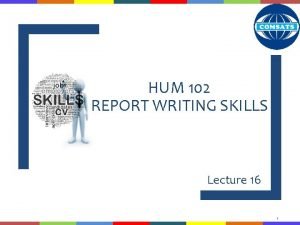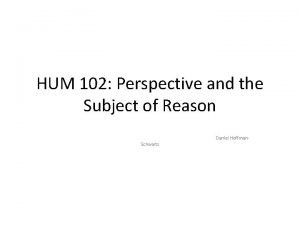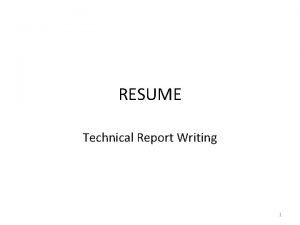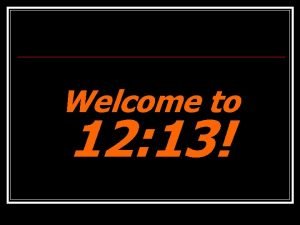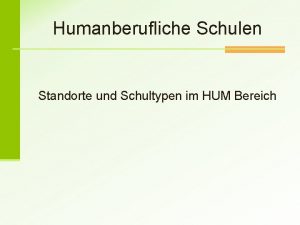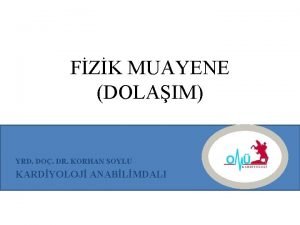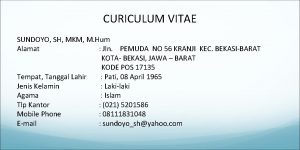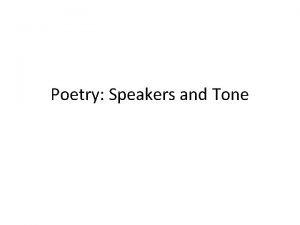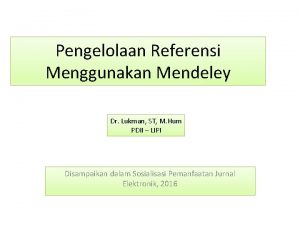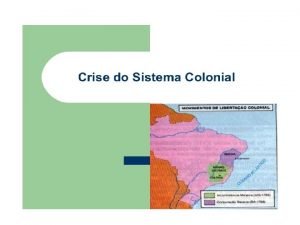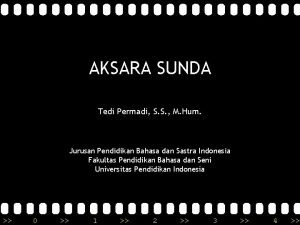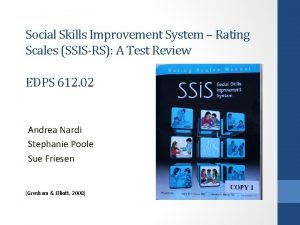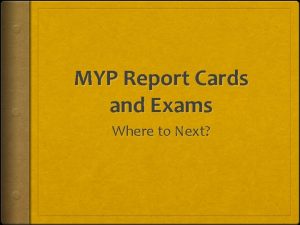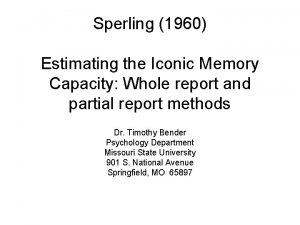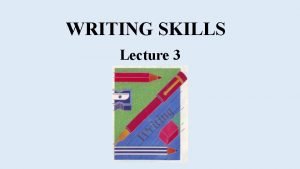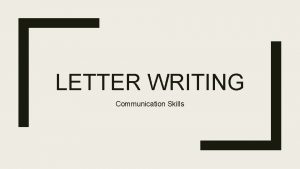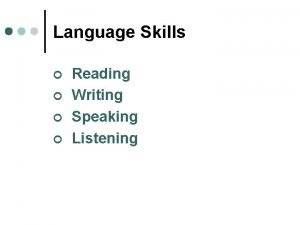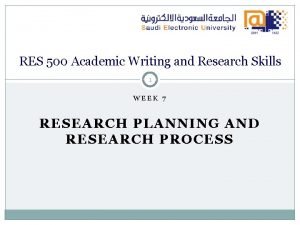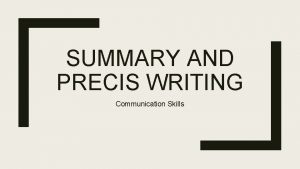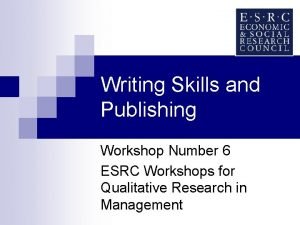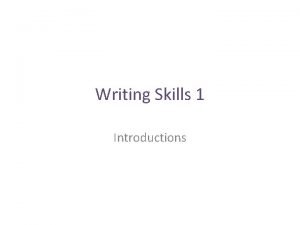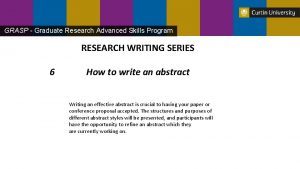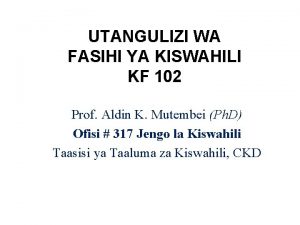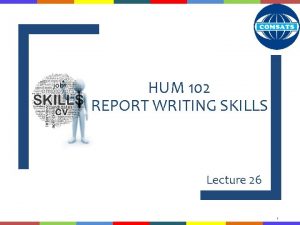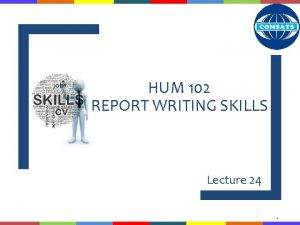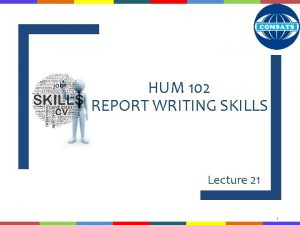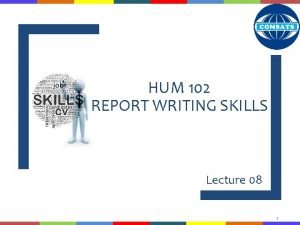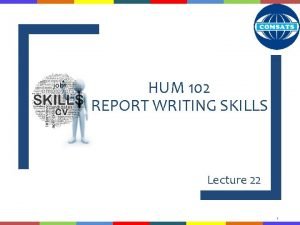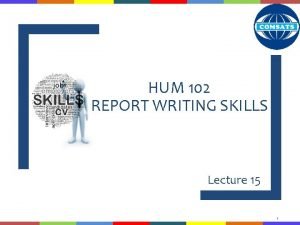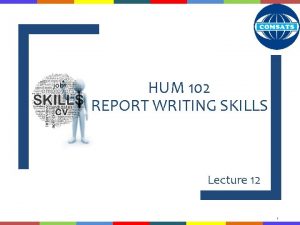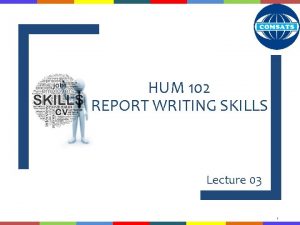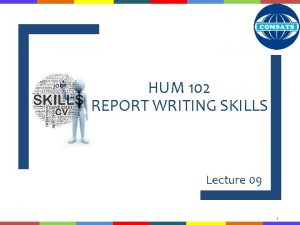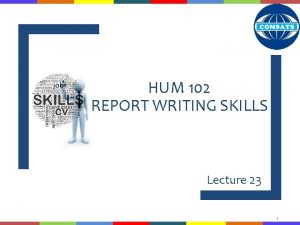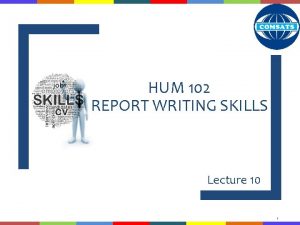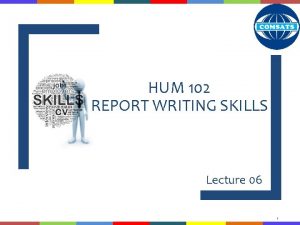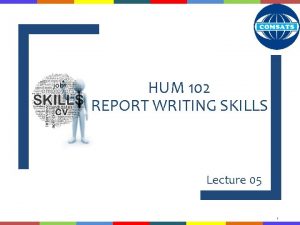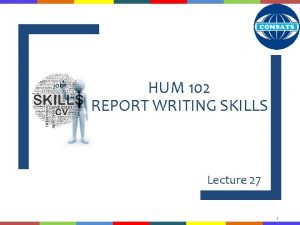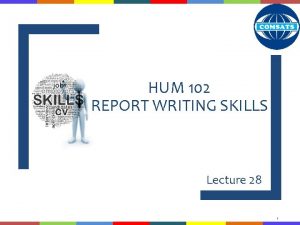HUM 102 REPORT WRITING SKILLS Lecture 16 1


![Memorandum q Format (Outer Frame) [1/2] 1. Memos have one-inch margins around the page. Memorandum q Format (Outer Frame) [1/2] 1. Memos have one-inch margins around the page.](https://slidetodoc.com/presentation_image_h/1987fa8ce6dba72d46920837ff3da13e/image-3.jpg)
![Memorandum q Format (Outer Frame) [2/2] • Be aware of the practices of addressing Memorandum q Format (Outer Frame) [2/2] • Be aware of the practices of addressing](https://slidetodoc.com/presentation_image_h/1987fa8ce6dba72d46920837ff3da13e/image-4.jpg)







![Memorandum q Structure (Inner Frame) • Message [1/2] o o o The content of Memorandum q Structure (Inner Frame) • Message [1/2] o o o The content of](https://slidetodoc.com/presentation_image_h/1987fa8ce6dba72d46920837ff3da13e/image-12.jpg)
![Memorandum q Structure (Inner Frame) • Message [2/2] o a) b) c) d) e) Memorandum q Structure (Inner Frame) • Message [2/2] o a) b) c) d) e)](https://slidetodoc.com/presentation_image_h/1987fa8ce6dba72d46920837ff3da13e/image-13.jpg)

![Memorandum q A long memo has different sub-sections • Introduction [1/3] o The introduction Memorandum q A long memo has different sub-sections • Introduction [1/3] o The introduction](https://slidetodoc.com/presentation_image_h/1987fa8ce6dba72d46920837ff3da13e/image-15.jpg)
![Memorandum q A long memo has different sub-sections • Introduction [2/3] o Two or Memorandum q A long memo has different sub-sections • Introduction [2/3] o Two or](https://slidetodoc.com/presentation_image_h/1987fa8ce6dba72d46920837ff3da13e/image-16.jpg)
![Memorandum q A long memo has different sub-sections • Introduction [3/3] o Explain why Memorandum q A long memo has different sub-sections • Introduction [3/3] o Explain why](https://slidetodoc.com/presentation_image_h/1987fa8ce6dba72d46920837ff3da13e/image-17.jpg)

![Memorandum q A long memo has different sub-sections • Analysis [1/3] o Before you Memorandum q A long memo has different sub-sections • Analysis [1/3] o Before you](https://slidetodoc.com/presentation_image_h/1987fa8ce6dba72d46920837ff3da13e/image-19.jpg)
![Memorandum q A long memo has different sub-sections • Analysis [2/3] o Specific Analysis Memorandum q A long memo has different sub-sections • Analysis [2/3] o Specific Analysis](https://slidetodoc.com/presentation_image_h/1987fa8ce6dba72d46920837ff3da13e/image-20.jpg)
![Memorandum q A long memo has different sub-sections • Analysis [2/3] o Significance of Memorandum q A long memo has different sub-sections • Analysis [2/3] o Significance of](https://slidetodoc.com/presentation_image_h/1987fa8ce6dba72d46920837ff3da13e/image-21.jpg)


![Example Memos [1/6] 24 Example Memos [1/6] 24](https://slidetodoc.com/presentation_image_h/1987fa8ce6dba72d46920837ff3da13e/image-24.jpg)
![Example Memos [2/6] 25 Example Memos [2/6] 25](https://slidetodoc.com/presentation_image_h/1987fa8ce6dba72d46920837ff3da13e/image-25.jpg)
![Example Memos [3/6] Source: http: //lib. vcomsats. edu. pk/library/HUM 100/COURSE%20 CONTENT/LECTURE%20 SLIDE/Lecture_23/What%20 is%20 a%20 Example Memos [3/6] Source: http: //lib. vcomsats. edu. pk/library/HUM 100/COURSE%20 CONTENT/LECTURE%20 SLIDE/Lecture_23/What%20 is%20 a%20](https://slidetodoc.com/presentation_image_h/1987fa8ce6dba72d46920837ff3da13e/image-26.jpg)
![Example Memos [4/6] 27 Example Memos [4/6] 27](https://slidetodoc.com/presentation_image_h/1987fa8ce6dba72d46920837ff3da13e/image-27.jpg)
![Example Memos [5/6] 28 Example Memos [5/6] 28](https://slidetodoc.com/presentation_image_h/1987fa8ce6dba72d46920837ff3da13e/image-28.jpg)
![Example Memos [6/6] Source: http: //lib. vcomsats. edu. pk/library/HUM 100/COURSE%20 CONTENT/LECTURE%20 SLIDE/Lecture_23/What%20 is%20 a%20 Example Memos [6/6] Source: http: //lib. vcomsats. edu. pk/library/HUM 100/COURSE%20 CONTENT/LECTURE%20 SLIDE/Lecture_23/What%20 is%20 a%20](https://slidetodoc.com/presentation_image_h/1987fa8ce6dba72d46920837ff3da13e/image-29.jpg)









- Slides: 38

HUM 102 REPORT WRITING SKILLS Lecture 16 1

Previous Lecture q Basics of Memo q Purpose of Memo q Structure of Memo q Types of Memo 2
![Memorandum q Format Outer Frame 12 1 Memos have oneinch margins around the page Memorandum q Format (Outer Frame) [1/2] 1. Memos have one-inch margins around the page.](https://slidetodoc.com/presentation_image_h/1987fa8ce6dba72d46920837ff3da13e/image-3.jpg)
Memorandum q Format (Outer Frame) [1/2] 1. Memos have one-inch margins around the page. 2. All lines of the memo begin at the left margin. 3. The text begins two spaces after the subject line. 4. The body of the memo is single-spaced, with two spaces between paragraphs. 5. The sender usually signs the memo using initials, first name, or complete name. 3
![Memorandum q Format Outer Frame 22 Be aware of the practices of addressing Memorandum q Format (Outer Frame) [2/2] • Be aware of the practices of addressing](https://slidetodoc.com/presentation_image_h/1987fa8ce6dba72d46920837ff3da13e/image-4.jpg)
Memorandum q Format (Outer Frame) [2/2] • Be aware of the practices of addressing and distributing memos in your organization. • Consider who should receive and in what order — senior managers, for example, take precedence over junior managers. • If rank does not apply, alphabetizing recipients by last name is safe. • Organization name, usually contained in the letterhead. • Electronic copies of memos should not include simulated initials. 4

Memorandum q Additional Pages • In case of a memo of more than one page, use a header, carry at least two lines of the body text over to that page. • The header should include either the recipient’s name or an abbreviated subject line, the page number, and the date. • Place the header in the upper left-hand corner or across the page. Source: Handbook of Technical Writing p. 329 5

Memorandum q Structure (Inner Frame) • To: o o For informal memos, the receiver's given name, e. g. , 'To: Andy' is enough. For more formal memos, use the receiver's full name. If the receiver is in another department, use the full name and the department name. It is usually not necessary to use Mr. , Mrs. , Miss or Ms. unless the memo is very formal. If you are sending the memo to several people, list them after “To”. If the list is longer than a dozen names, place it at the end of the memo and reference it on the “To” line. 6

Memorandum q Structure (Inner Frame) • From: o o o The writer's name and professional title go after this heading. A 'From' section containing the name of the sender. For informal memos, the sender’s first name, e. g. , 'From: Bill' is enough. For more formal memos, use the sender's full name. If the receiver is in another department, use the full name and the department name. It is usually not necessary to use Mr. , Mrs. , Miss or Ms. unless the memo is very formal. 7

Memorandum q Structure (Inner Frame) • Date: o o Dating a memo gives the organization a record of its correspondence. To avoid confusion between the British and American date systems, write the month as a word or an abbreviation; e. g. 'January' or 'Jan’. • Subject: o o State the topic in a few words but make sure it communicates the point of the memo. E. g. , “Changes in Employee Medical Benefits” is more specific than “Employee Benefits Program”. Note: The order and placement of these headings may vary from organization to organization. The “To” line eliminates the need for a salutation, e. g. , “Dear Mrs. Bernstein”. 8

Memorandum q Subject Line • First line of communication. • Includes a topic and a focus. Example: Subject: Request for Month-end Expenditures Focus Topic 9

Memorandum Source: Handbook of Technical Writing p. 329 10

Memorandum For example, a successful subject line would read as follows Subject: VACATION SCHEDULE FOR ACCOUNTANTS Accountants is the topic of the memo; vacation schedule is the focus. The focus aids communication more than the topic. The topic of a memo, for instance, can stay the same, while the focus changes. Look at the following examples: Subject: SALARY INCREASE FOR ACCOUNTANTS Subject: TERMINATION OF ACCOUNTANTS In each of these instances, the topic stays the same: Accountants. Notice, then, how important the focus comments are. We see a huge difference between salary increases, vacation schedules, and termination. In addition to the identification lines, memos are initialed next to the From line. 11
![Memorandum q Structure Inner Frame Message 12 o o o The content of Memorandum q Structure (Inner Frame) • Message [1/2] o o o The content of](https://slidetodoc.com/presentation_image_h/1987fa8ce6dba72d46920837ff3da13e/image-12.jpg)
Memorandum q Structure (Inner Frame) • Message [1/2] o o o The content of the memo should consist of a concise introduction, one or more middle paragraphs conveying the details, and perhaps a brief conclusion. Some memos are as short as one paragraph, or even one sentence. Memo length is determined by the purpose and audience. 12
![Memorandum q Structure Inner Frame Message 22 o a b c d e Memorandum q Structure (Inner Frame) • Message [2/2] o a) b) c) d) e)](https://slidetodoc.com/presentation_image_h/1987fa8ce6dba72d46920837ff3da13e/image-13.jpg)
Memorandum q Structure (Inner Frame) • Message [2/2] o a) b) c) d) e) Unless the memo is a brief note, a well-organized memo message should contain the following sections: Situation - an Introduction or the purpose of the memo. Problem (optional) - for example: "Since the move to the new office in Kowloon Bay, staff has difficulty in finding a nearby place to buy lunch. " Solution (optional) - for example: "Providing a microwave oven in the pantry would enable staff to bring in their own lunchboxes and reheat their food. " Action - this may be the same as the solution, or be the part of the solution that the receiver needs to carry out; e. g. "we would appreciate it if you could authorize up to $3, 000". Politeness - to avoid the receiver refusing to take the action you want, it is important to end with a polite expression; e. g. "Once again, thank you for your support. ", or more informally "Thanks". 13

Memorandum q A long memo has different sub-sections • Summary o A summary, placed at the beginning of the memo, should condense the subject to five or ten lines. It should not contain jargon or highly technical language. 14
![Memorandum q A long memo has different subsections Introduction 13 o The introduction Memorandum q A long memo has different sub-sections • Introduction [1/3] o The introduction](https://slidetodoc.com/presentation_image_h/1987fa8ce6dba72d46920837ff3da13e/image-15.jpg)
Memorandum q A long memo has different sub-sections • Introduction [1/3] o The introduction states the memo's purpose and scope. You may add a paragraph or two of background material if the reader needs more information. o The introduction may also be used to ask or answer key questions, thank the reader, or give good news such as the approval of a proposal. o If you must refuse a request or reject an offer, use the introduction to establish your reasons before saying “no”. 15
![Memorandum q A long memo has different subsections Introduction 23 o Two or Memorandum q A long memo has different sub-sections • Introduction [2/3] o Two or](https://slidetodoc.com/presentation_image_h/1987fa8ce6dba72d46920837ff3da13e/image-16.jpg)
Memorandum q A long memo has different sub-sections • Introduction [2/3] o Two or three sentences that orient your reader about why your are writing to him or her. o This should not be an editorial (for example, don't include philosophy about how important this issue is to your company--your readers already know that). o Rather, the Introduction should inform the reader about specific background info regarding the project you are writing about (for example, who, what, when, where, why). o In most analytical memos, your tone should be unemotional and objective. 16
![Memorandum q A long memo has different subsections Introduction 33 o Explain why Memorandum q A long memo has different sub-sections • Introduction [3/3] o Explain why](https://slidetodoc.com/presentation_image_h/1987fa8ce6dba72d46920837ff3da13e/image-17.jpg)
Memorandum q A long memo has different sub-sections • Introduction [3/3] o Explain why you are writing (purpose). o State what you are writing about (subject). Example: Why you are writing? To help me complete my monthly budget report, please send me a copy of your month-end expenditures. What you are writing about? 17

Memorandum q A long memo has different sub-sections • Discussion o The facts of a situation need to be accurately identified and presented, and the arguments need to be reasoned and supported carefully. o Explanation. o Itemize your needs for easy access. Example: Be sure to include the following expenses: details • Mileage • Food • Hotel room charges 18
![Memorandum q A long memo has different subsections Analysis 13 o Before you Memorandum q A long memo has different sub-sections • Analysis [1/3] o Before you](https://slidetodoc.com/presentation_image_h/1987fa8ce6dba72d46920837ff3da13e/image-19.jpg)
Memorandum q A long memo has different sub-sections • Analysis [1/3] o Before you engage in any analysis you need to tell your reader some things: a) Data: What data will you be using? How and where did you obtain the data? b) Method. : What methods will you be using to analyze your data? c) Assumptions: Are there some key assumptions that you will be making during your analysis? 19
![Memorandum q A long memo has different subsections Analysis 23 o Specific Analysis Memorandum q A long memo has different sub-sections • Analysis [2/3] o Specific Analysis](https://slidetodoc.com/presentation_image_h/1987fa8ce6dba72d46920837ff3da13e/image-20.jpg)
Memorandum q A long memo has different sub-sections • Analysis [2/3] o Specific Analysis a) This section may also be labeled "Findings", "Details", "Results", or something else that signifies that this is where you provide the details of your analysis. b) This is for the reader that needs more specific information than the summary info presented in the key points listed above. 20
![Memorandum q A long memo has different subsections Analysis 23 o Significance of Memorandum q A long memo has different sub-sections • Analysis [2/3] o Significance of](https://slidetodoc.com/presentation_image_h/1987fa8ce6dba72d46920837ff3da13e/image-21.jpg)
Memorandum q A long memo has different sub-sections • Analysis [2/3] o Significance of Data a) Most analytical reports require the incorporation of data in order to be convincing. b) Data provide a sense of objectivity and encourage "managing by fact". c) Data are usually expressed in either tables or graphs. d) They can be placed inside the analysis section or at the end of the report as attachments. e) In either case, all tables and graphs should have a title and its numerical reference. 21

Memorandum q A long memo has different sub-sections • The conclusion summarizes the main points and discusses what action is required of the readers. • The “From” line eliminates the need for a complimentary close (e. g. “Yours faithfully”). • Writer’s initials – a memo is completed by the writer's initials, not his/her signature, immediately after the last sentence. • Distribution list – names on the distribution list are usually typed in alphabetical order. However, if one of the individuals clearly outranks the others, place that name first. • Attachments – if you have attachments, you may list them at the top of the memo or at the end. • Copies – a duplicate copy of the memo should be held for future reference. 22

Memorandum q A long memo has different sub-sections • Conclusion State what’s next o When you expect a follow-up? o Why that date is important? Example: When Please send your month-end expenditures by Wednesday at 3: 00 p. m. This will allow me to complete the budget report by John’s deadline. Why 23
![Example Memos 16 24 Example Memos [1/6] 24](https://slidetodoc.com/presentation_image_h/1987fa8ce6dba72d46920837ff3da13e/image-24.jpg)
Example Memos [1/6] 24
![Example Memos 26 25 Example Memos [2/6] 25](https://slidetodoc.com/presentation_image_h/1987fa8ce6dba72d46920837ff3da13e/image-25.jpg)
Example Memos [2/6] 25
![Example Memos 36 Source http lib vcomsats edu pklibraryHUM 100COURSE20 CONTENTLECTURE20 SLIDELecture23What20 is20 a20 Example Memos [3/6] Source: http: //lib. vcomsats. edu. pk/library/HUM 100/COURSE%20 CONTENT/LECTURE%20 SLIDE/Lecture_23/What%20 is%20 a%20](https://slidetodoc.com/presentation_image_h/1987fa8ce6dba72d46920837ff3da13e/image-26.jpg)
Example Memos [3/6] Source: http: //lib. vcomsats. edu. pk/library/HUM 100/COURSE%20 CONTENT/LECTURE%20 SLIDE/Lecture_23/What%20 is%20 a%20 memo. pdf 26
![Example Memos 46 27 Example Memos [4/6] 27](https://slidetodoc.com/presentation_image_h/1987fa8ce6dba72d46920837ff3da13e/image-27.jpg)
Example Memos [4/6] 27
![Example Memos 56 28 Example Memos [5/6] 28](https://slidetodoc.com/presentation_image_h/1987fa8ce6dba72d46920837ff3da13e/image-28.jpg)
Example Memos [5/6] 28
![Example Memos 66 Source http lib vcomsats edu pklibraryHUM 100COURSE20 CONTENTLECTURE20 SLIDELecture23What20 is20 a20 Example Memos [6/6] Source: http: //lib. vcomsats. edu. pk/library/HUM 100/COURSE%20 CONTENT/LECTURE%20 SLIDE/Lecture_23/What%20 is%20 a%20](https://slidetodoc.com/presentation_image_h/1987fa8ce6dba72d46920837ff3da13e/image-29.jpg)
Example Memos [6/6] Source: http: //lib. vcomsats. edu. pk/library/HUM 100/COURSE%20 CONTENT/LECTURE%20 SLIDE/Lecture_23/What%20 is%20 a%20 memo. pdf 29

Memorandum q Microsoft Word’s Wizards/Templates • Microsoft Word’s Wizards/Templates help students to write memos (and letters, fliers, résumés, etc. ). • Students can access Wizards/Templates by clicking on File, scrolling to New, and then clicking on the Memos tab. Inside this file, they’ll find templates for contemporary, professional, and elegant memos. • Wizards/Templates help students format memos and provide the standard memo components. However, templates are restrictive, limiting the students’ options. 30

Writing a Memo in Word 31

Write the Heading Segment 32

Opening Segment 33

Expanding in Discussion Segment 34

Include a Summary Segment 35

Finish with a Closing Segment 36

Close with a Call to Action Source: lib. vcomsats. edu. pk/. . . /How%20 to%20 Write%20 a%20 Memo%20 with%20 images. pdf 37

Conclusions • Format of Memo • Structure of Memo 38
 Hum 102
Hum 102 Hum 102
Hum 102 Report writing skills resume
Report writing skills resume 01:640:244 lecture notes - lecture 15: plat, idah, farad
01:640:244 lecture notes - lecture 15: plat, idah, farad Abe hum pen thin height meaning
Abe hum pen thin height meaning Ho hum when he's finished pecking down
Ho hum when he's finished pecking down Hum schultyp
Hum schultyp Hum schultyp
Hum schultyp Juguler ven
Juguler ven Mkm.m
Mkm.m Types of speakers in poems
Types of speakers in poems Dr. lukman, s.t., m.hum.
Dr. lukman, s.t., m.hum. Brancusi
Brancusi Conjuração mineira resumo
Conjuração mineira resumo Oh so hum
Oh so hum Alice hum
Alice hum Panyakra aksara sunda
Panyakra aksara sunda Interpersonal communication vs intrapersonal
Interpersonal communication vs intrapersonal What is skill
What is skill Ontario skills passport essential skills
Ontario skills passport essential skills Ssis rating scale sample report
Ssis rating scale sample report What is schematic report in business communication
What is schematic report in business communication Ontario report card learning skills
Ontario report card learning skills Myp cards
Myp cards Difference between status report and progress report
Difference between status report and progress report Sperling 1960
Sperling 1960 Principles of teaching writing
Principles of teaching writing Functional writing meaning
Functional writing meaning Letter writing communication skills
Letter writing communication skills Importance of speaking
Importance of speaking Conclusion for writing skills
Conclusion for writing skills Academic writing and research skills
Academic writing and research skills Summary or precis
Summary or precis Objectives of writing skills
Objectives of writing skills Introduction of writing skills
Introduction of writing skills Structured abstract
Structured abstract 4 forces of nature
4 forces of nature Physics 102 uiuc
Physics 102 uiuc Maana ya fasihi ya kiswahili
Maana ya fasihi ya kiswahili
